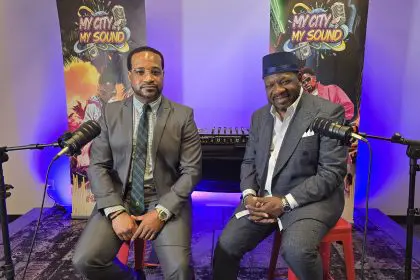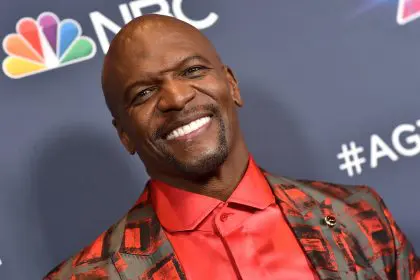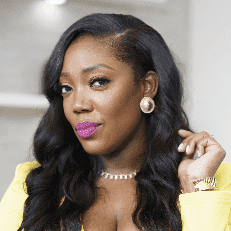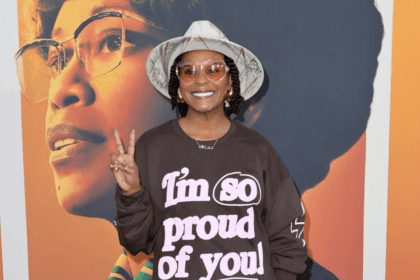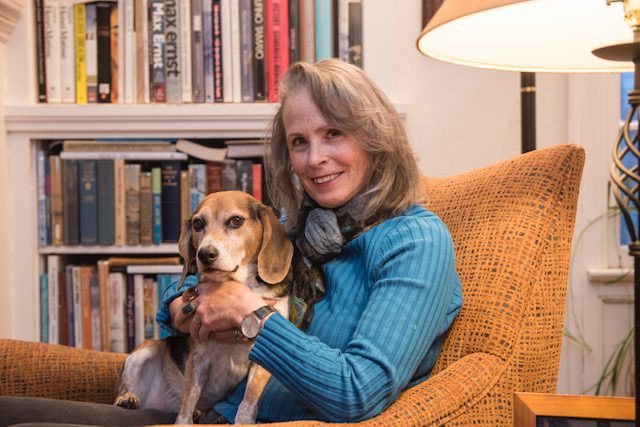
Mary Ann Cain’s South Side Venus: The Legacy of Margaret Burroughs takes readers on a journey of the extraordinary productive life of curator, artist and activist Margaret Burroughs. The long-awaited biography draws on author-based interviews, as well as interviews with peers, colleagues, friends and family, and extensive archival research at the DuSable Museum, the Art Institute of Chicago, and the Chicago Public Library. Cain follows Burrough’s multifaceted career as she highlights her relationships with other artists and culture makers and illustrates Burroughs as a teacher, mentor and institution builder. In addition, Cain also discusses in detail Burroughs’ work and residency on Chicago’s South Side.
Cain’s book goes into details about Burroughs work to establish and sustain two significant institutions in Chicago: the South Side Community Art Center (SSAC), founded in 1940 and the DuSable Museum of African American History, founded in her living room in 1961. As the biography reveals, the principal inspiration for Burroughs efforts were love and hope. Burroughs’ love for Chicago’s under-served African American community was impelled by her hope that these two African American cultural centers would welcome many generations of aspiring artists and art lovers.
Cain, known for her critical work on writing theory and praxis, has also authored fiction and nonfiction essays, and poems that have appeared in numerous literary journals. She’s currently a professor of English at Purdue University Fort Wayne, where she teaches fiction, creative nonfiction, rhetoric and women’s studies.
What is the mission you set out to accomplish with your voice in this book?
My mission was clear and straightforward—I wanted people from across the spectrum to know and appreciate Dr. Burroughs as the “renaissance woman,” the stand-up, nobody-owns-her person that others knew her to be. I was not trying to be “objective” or distanced; I leave that to future writers and scholars. For the brief time that I knew her and the few meetings that we had, I wanted to embody how powerfully she impacted people, including me, because of her generosity, courage, and honesty. And of course her amazing art.
What was the hardest part of completing this project?
Getting the time and resources to write. I knew what I wanted to do; Dr. Burroughs left a lot of her life story in various interviews, an autobiography, and so forth. Aside from some hefty personal challenges, there was also just the difficulty of making time and gaining access to resources. It took time to ask for resources.
If you had to do it all over again, would you change anything about your latest work?
If I had more time and resources, I would have loved to have interviewed more people who knew Dr. Burroughs. I would have liked to have had more time to search her archives at the DuSable Museum. As it is, I regard this book as just the beginning of the scholarship and writing that can and should be done about her legacy. In particular, somebody needs to catalogue her art.
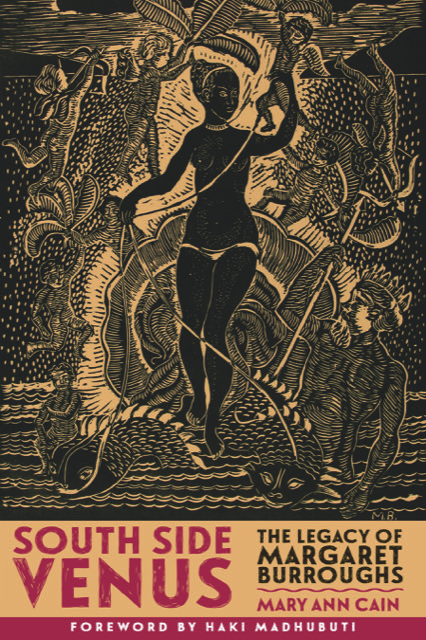
Describe the process in getting published?
For this book, it was surprisingly straightforward, unlike other books and journal publications I’ve had. I knew that Dr. Burroughs had taken classes at Northwestern University. I know the press has partnered at times to promote Third World Press, run by one of Margaret and Charles Burroughs’s mentees, Haki Madhubuti. I knew the press was looking for Chicago luminaries to feature. So, when I approached an acquisitions editor at a conference, I had his interest right away. I wrote a prospectus, signed an advance contract, and then just plugged away for several more years to get a manuscript together. It was sent for outside review before it was officially accepted. I used those comments to revise.
What were the literary, psychological and/or logistical challenges in bringing your work to life?
At first I wanted to weave more of my own experiences into the book—how my life intersected with Dr. Burroughs, how her art impacted me. But as I began interviewing people who knew her, it was clear that my focus needed to be firmly on her and her legacy. My purpose was a bit foggy at first but it got clearer as I tried bits and pieces out on my editors and on local (Fort Wayne) audiences. I’ve never written a biography before, and I’m not an art historian, so I was a bit outside my expertise. But I knew a good story when I saw one, and Dr. Burroughs’s life and work certainly met that standard.
Please provide three “good to know” facts about you. Be creative. Tell us about your first job or the inspiration behind your writing.
First, I am doggedly persistent; if I want something to get done, I will not stop until I’ve exhausted all possible avenues. For instance, I tried to get Michelle Obama, a native Chicago South Sider and an acquaintance of Dr. Burroughs, to write an introduction to my latest book. (In hindsight, I’m glad it didn’t work out; Haki Madhubuti is absolutely the right person). I researched, wrote letters, asked friends of friends, and eventually wound up getting in touch with her press secretary. She said no. But I at least I got a direct answer!
Second, my early inspiration for writing was a collection of leather-bound fairy tales that my mother would read as bedtime stories. I still remember this one image of a saucer-eyed dog, but I could never find that story again on my own. I loved anything with animals, especially dogs and horses, but I also loved descriptions of food. I still love “food porn” –that is, vivid descriptions of something a character is eating, such as in the Little House books. I read cookbooks, too!
Third, I like to experiment. I try all kinds of strange foods—I’m working up to eating jelly fish, but I already know I love sweetbreads. And yet I mostly like eating vegetarian food, even vegan. Last summer I experimented with planting vegetables in hay bales. I have a small yard with limited sunlight, so I could move the bales to the sunniest spots. Worked well! I experiment with footwear; I own four pairs of Vibram FiveFinger shoes. I no longer wear orthotics. I experiment with language; when I was recovering from breast cancer in 2012-2013, I started writing poetry and recently completed a chapbook. Prose just didn’t get to what I was feeling and how I wanted to express my sense of self that came from that life-changing experience. As I mentioned earlier, I live with a poet, so I had a built-in audience and editor.
What inspired you to write your first book?
My first book was for an academic audience based on my dissertation. But my first literary book, Down from Moonshine (Thirteenth Moon Press, 2009) was inspired by a college summer job at a white-tablecloth restaurant outside Chicago called The Old Barn. Lots of kids who grew up around there worked as bussers, servers, and so forth. In a white flight suburb, it was one of the only places where blacks were seen and interacted with. There were lots of stories and gossip about that place.
Do you have a specific writing style?
It depends on what I am writing, but generally I am attentive to minute details, rich language, precise diction, rhythm, flow, and figures of speech. I live with a poet, so perhaps it’s inescapable.
What books have most impacted your life (or life as an author)?
There are so many that it’s hard to pinpoint. When women authors began to get more recognition, I was extremely attentive to Toni Morrison, Alice Walker, Louise Erdrich, Toni Cade Bambara, and other authors who emerged in the 1970s and 80s. I love Virginia Woolf and other modernists. In graduate school I was introduced to Mary Austin.
What books are you currently reading? Why this author?
I’ve been reading novels by Barbara Kingsolver. Her background as a biologist informs a lot of her subject matter. Her characters and plots are absorbing.
I just read Mongrels by Stephen Graham Jones. He was recommended by some friends; I picked it for my fiction writing students, who did, indeed, love it—a mixture of horror, myth, and coming of age. I would not have picked it for myself, but I certainly learned a lot reading it.
What new authors have piqued your interest?
In the nonfiction area, I loved Keeyanga Yamatta Taylor’s interviews with the Combahee River Collective called How We Get Free. It also includes an interview with Alicia Garza, found of Black Lives Matter, in which she acknowledges the legacy of the Collective on that movement.
Is there anything you find particularly challenging about writing or coming up with a concept for your book?
I just wrote a proposal for my next book. The challenge is not in coming up with a concept as much as it is focusing all the divergent strands of thought that I usually have. I have lots of ideas; the challenge is to capture them and find ways to make them relate to each other.
What advice would you give other writers?
I am an extremely persistent person. If someone says no, I go back and think about why. I may make changes and/or I might just try someone else to publish my work. When I am writing, I know I can revise successfully. And if I can’t get it right, I know when to move on. Writing is a process; you learn from everything, even your “mistakes.”
Everyone’s process for writing is different. Explain yours.
Mine continues to evolve. I’ve learned to pay attention to little scraps of thinking, images, ideas that come at unexpected moments. I keep files of little bits of paper; I’m especially fond of sticky notes. I learned to keep organized; files, book shelves, contact lists. I collect even very peripheral things just in case. I write in a journal, sometimes just to touch base with myself. I exercise and also walk my dog. Some of the best ideas come during exercise. In the summer, when I’m not teaching, I try to get a routine going: walk the dog, do some yoga, meditate, then write for a few hours. I like to cook when I have time—good ideas come then, too, especially after a writing session. And then I jog or walk with my husband in the evening, do some reading before sleep.
What are five of your favorite books and why?
I read so much as a child that I have to start with those volumes—I loved all the “Little House” books, along with other books that introduced me to other cultures and histories. My eyes were opened to my hometown’s history with Upton Sinclair’s novel, The Jungle. A high school English teacher turned us on to The Autobiography of Malcolm X and Lysistrata, the play; this was during the height of the anti-war, civil rights, and black power movements. Although I later became more critical of her, Anais Nin’s work, especially her diaries (which I later learned were heavily edited and even deceptive) got me interested in modernist literature and also surrealist art and film. I like challenging reads such as Barbara Kingsolver’s The Poisonwood Bible and indigenous authors such as Leslie Marmom Silko, who wrote Ceremony. I also like Arundhati Roy’s fiction and nonfiction. I am hoping to get to her latest novel, The Ministry of Utmost Happiness, over the holiday break.
Who are the authors you reread and why?
I reread a lot for the classes I teach. Happily, I recently reread Virginia Woolf. I love William Faulkner. Alice Walker is up there. But I also read theorists—authors, people outside academia wouldn’t know about, such as Edward Soja and his Third Space theory. I like to reread works that challenge me and that give me something new each time I read them.
A great book has what?
Finely crafted language. Powerful ideas. Longevity, not just faddishness.
You develop character and ideas by….
Observing people, reading other people’s characters, reading lots of current event articles and essays. I admit I read a lot of shared work on Facebook in those scraps of times when I want a break from a more concentrated task.
Where would you travel to write your next book?
My next book is looking at our sense of home and its deeply shaping effects on our identity, in my case, the south side of Chicago. I’d love to explore the homelands of people who made the south side what it is, including my ancestors from Europe and Great Britain, but also those who came north during the Great Migrations. West Africa would be amazing.
What is the gift of reading and why does it bring about a new world?
Reading as a child opened up new worlds and experiences. While my immediate world seemed fairly stable and also a bit cloistered, reading opened up other possibilities. I didn’t have to settle; I learned how my imagination could lead me in other directions. Lucky for me I had parents who were readers and took us to the public library on a regular basis and also bought us books.




